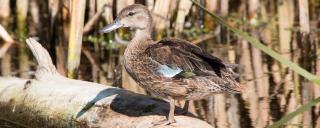
Breeding Waterfowl Habitat
General Information
Eleven species of waterfowl commonly nest in North Dakota, with blue-winged teal the most abundant. Of these species, seven are dabbling ducks (e.g., mallards and pintails), three are diving ducks (e.g., lesser scaup and canvasbacks); also included are Canada geese from the Great Plains population. North Dakota also falls into the “fringe” of six other waterfowl species’ breeding ranges, most of which are diving ducks (e.g., ring-necked ducks). North Dakota is part of the Prairie Pothole Region, North America’s most important waterfowl breeding area for ducks, supporting approximately 50 percent of the continent’s breeding duck population. Waterfowl conservation has been supported primarily by hunters from the migratory bird hunting stamp or duck stamp. Funds from this stamp have conserved waterfowl habitat across North America since 1934, and have provided habitat for many other wetland and grassland bird species. The Conservation Reserve Program has provided substantial breeding habitat for grassland and wetland bird species in the form of large tracts of upland nesting cover and wetland restorations.
General Habitat Requirements
Breeding dabbling ducks require invertebrate rich, dynamic wetland communities for pairing, nutrient acquisition for nesting and egg formation, and brood rearing. Shallow, temporary wetlands typically dry up by late spring and are used for pairing and nutrient acquisition. Seasonal and semi-permanent (1.5-5 feet) wetlands are used for brood rearing and also nutrient acquisition by renesting ducks. These seasonal/semi-permanent wetlands are also used by diving ducks and Canada geese for nesting and brood rearing. Dabbling ducks also require large contiguous stands of dense upland cover comprised of grasses and forbs for nesting. Ducks will nest in small patches of grass and bushes, but these nests are prone to destruction by predators. Mallards, gadwall and pintails have been known to nest one mile or more from brood rearing wetlands. Diving ducks generally build over-water nesting platforms from wetland vegetation, but may also nest in the uplands (lesser scaup), or lay eggs (redheads) in active nests of other ducks.
Management Considerations
- Do not drain or fill to eliminate wetlands, or alter hydrology to artificially deepen wetlands.
- Preserve undisturbed grasslands, native rangelands, and other low-growing grassy and shrubby habitats, especially those within one mile of wetlands.
- Preserve and maintain grassland/forb communities in large (over 40 acres) contiguous tracts as possible, by prescribed rotational burning and rotational mowing when and where appropriate, prepare crop fields in early spring (March through late April) before peak nesting season, and plow fields to be left idle for a growing season in late July after nesting activities have ceased. <'/
- When cutting hay or mowing, leave the highest possible height (12-24 inches).
- Use a stripper header, and delay cutting until after primary nesting season (April 15 through August 1).
- Use flushing bars, avoid night mowing, and cut hay fields from the center outward or toward undisturbed habitat.
- Restore hydrology and vegetation to degraded wetlands.
- Leave grassed buffer strips around wetlands and along waterways in cropped areas to prevent soil erosion, chemical runoff, nutrification and sedimentation in wetlands.
- A 50-foot strip of tall dense grass around wetlands can deter family groups of Canada geese from walking into surrounding crop fields to feed on developing plants.
- Stocking fish in shallow wetlands is detrimental to waterfowl production.
- Control tall woody vegetation, including single trees that act as raptor perches and raptor nest sites.
- Maintain grasslands free of or with little woody vegetation.
- Include direct seeded winter cereal crops in the crop rotations to provide early spring growth for nesting habitat.
Note: More information on mallard habitat needs can be found in the Farm and Ranch Guide to Developing and Maintaining Wildlife Habitat on the Northern Great Plains.
